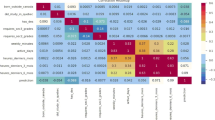Abstract
Nowadays, the issue of student drop-out is addressed not only through the prism of pedagogy, but also by technological practices. In this paper, we demonstrate how a student drop-out could be predicted through a student’s performance using different Machine Learning techniques, i.e., supervised learning and unsupervised learning. The results show that various types of student engagement are essential factors in predicting drop-out and the final ECTS points achievements.
Access this chapter
Tax calculation will be finalised at checkout
Purchases are for personal use only
Similar content being viewed by others
References
Truta, C., Parv, L., Topala, I.: Academic engagement and intention to drop out: levers for sustainability in higher education. Sustainability 10(12), 4637 (2018)
Ruiz, N., Fandos, M.: The role of tutoring in higher education: improving the student’s academic success and professional goals. Revista Internacional de Organizaciones (12), 89–100 (2014)
Hellas, A., et al.: Predicting academic performance: a systematic literature review. In: Proceedings Companion of the 23rd Annual ACM Conference on Innovation and Technology in Computer Science Education, pp. 175–199 (2018)
Nicoletti, M.C.: Revisiting the tinto’s theoretical dropout model. High. Educ. Stud. 9(3), 52–64 (2019)
Lei, H., Cui, Y., Zhou, W.: Relationships between student engagement and academic achievement: a meta-analysis. Soc. Behav. Personal. Int. J. 46(3), 517–528 (2018)
Nalli, G., Amendola, D., Smith, S.: Artificial intelligence to improve learning outcomes through online collaborative activities. In: European Conference on e-Learning, vol. 21, pp. 475–479 (2022)
Lee, S., Chung, J.Y.: The machine learning-based dropout early warning system for improving the performance of dropout prediction. Appl. Sci. 9(15), 3093 (2019)
Burgos, C., Campanario, M.L., de la Peña, D., Lara, J.A., Lizcano, D., Martínez, M.A.: Data mining for modeling students’ performance: a tutoring action plan to prevent academic dropout. Comput. Electr. Eng. 66, 541–556 (2018)
Bedregal-Alpaca, N., Cornejo-Aparicio, V., Zárate-Valderrama, J., Yanque-Churo, P.: Classification models for determining types of academic risk and predicting dropout in university students. Int. J. Adv. Comput. Sci. Appl. 11(1), 266–272 (2020)
Oloruntoba, S., Akinode, J.: Student academic performance prediction using support vector machine. Int. J. Eng. Sci. Res. Technol. 6(12), 588–597 (2017)
Cunningham, P., Cord, M., Delany, S.J.: Supervised learning. In: Cord, M., Cunningham, P. (eds.) Machine Learning Techniques for Multimedia. Cognitive Technologies, pp. 21–49. Springer, Heidelberg (2008). https://doi.org/10.1007/978-3-540-75171-7_2
Barlow, H.B.: Unsupervised learning. Neural Comput. 1(3), 295–311 (1989)
Äyrämö, S., Kärkkäinen, T.: Introduction to partitioning-based clustering methods with a robust example. Reports of the Department of Mathematical Information Technology. Series C, Software engineering and computational intelligence, no. 1/2006 (2006)
Leung, Y., Zhang, J.-S., Xu, Z.-B.: Clustering by scale-space filtering. IEEE Trans. Pattern Anal. Mach. Intell. 22(12), 1396–1410 (2000)
Jain, A.K., Duin, R.P.W., Mao, J.: Statistical pattern recognition: a review. IEEE Trans. Pattern Anal. Mach. Intell. 22(1), 4–37 (2000)
Brezočnik, L., Fister, I., Podgorelec, V.: Swarm intelligence algorithms for feature selection: a review. Appl. Sci. 8(9), 1521 (2018)
Brezočnik, L.: Feature selection for classification using particle swarm optimization. In: IEEE EUROCON 2017–17th International Conference on Smart Technologies, pp. 966–971. IEEE (2017)
Karakatič, S., Fister, I., Fister, D.: Dynamic genotype reduction for narrowing the feature selection search space. In: 2020 IEEE 20th International Symposium on Computational Intelligence and Informatics (CINTI), pp. 35–38. IEEE (2020)
Fister, D., Fister, I., Karakatič, S.: Dynfs: dynamic genotype cutting feature selection algorithm. J. Ambient Intell. Humaniz. Comput. 1–14 (2022)
Karakatič, S.: Evopreprocess—data preprocessing framework with nature-inspired optimization algorithms. Mathematics 8(6), 900 (2020)
Shutaywi, M., Kachouie, N.N.: Silhouette analysis for performance evaluation in machine learning with applications to clustering. Entropy 23(6), 759 (2021)
Acknowledgements
The authors acknowledge the financial support from the Slovenian Research Agency (Research Core Funding No. P2-0057), and the European Commission (Project Code 2020-1-ES01-KA203-082090).
Author information
Authors and Affiliations
Corresponding author
Editor information
Editors and Affiliations
Rights and permissions
Copyright information
© 2023 The Author(s), under exclusive license to Springer Nature Switzerland AG
About this paper
Cite this paper
Brezočnik, L., Nalli, G., De Leone, R., Val, S., Podgorelec, V., Karakatič, S. (2023). Machine Learning Model for Student Drop-Out Prediction Based on Student Engagement. In: Karabegovic, I., Kovačević, A., Mandzuka, S. (eds) New Technologies, Development and Application VI. NT 2023. Lecture Notes in Networks and Systems, vol 687. Springer, Cham. https://doi.org/10.1007/978-3-031-31066-9_54
Download citation
DOI: https://doi.org/10.1007/978-3-031-31066-9_54
Published:
Publisher Name: Springer, Cham
Print ISBN: 978-3-031-31065-2
Online ISBN: 978-3-031-31066-9
eBook Packages: Intelligent Technologies and RoboticsIntelligent Technologies and Robotics (R0)




